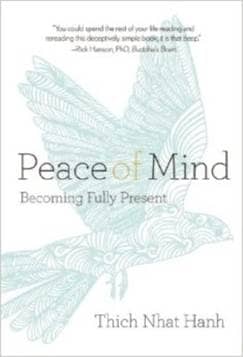
Reprinted from Peace of Mind: Becoming Fully Present (2013) by Thich Nhat Hanh with permission of Parallax Press, Berkeley, California. www.parallax.org
If you have an unpleasant feeling, a feeling of sadness, fear, worry, or despair, you may think you don’t have the capacity to return home to be in touch with that emotion, to manage and embrace it. You want to run away from it—and you have many ways to run away, like magazines, books, music, food, the Internet, or busily strategizing—so you won’t be in touch with your body and mind. Mind and body are alienated from each other, and this makes us sick.
When some catastrophe happens, when you have a painful feeling in your body, when something isn’t going well, when you have a strong emotion, mindfulness will help you to be aware of it, and you will be able to do something to soothe and calm that pain. Mindfulness puts you in touch with the positive things, and it can also help you be present and skillful with things that are unpleasant.
You may have anger. Anger can ravage your mind and body. But if you can breathe mindfully, come back to the present moment, and get in touch with your body and with your feelings and embrace them, there is already some relief. “Breathing in, I know that anger is in me. Breathing out, I embrace my anger.” There’s already a difference. If we don’t practice mindfulness and embracing, then there’s just the anger, that one energy, in us. Left to its own devices, that energy can push us to say and do things that will cause damage.
So when the anger comes up, you practice. You practice mindful breathing, and you generate the energy of mindfulness.
Breathing in, I know that anger is there in me.
Breathing out, I embrace the anger in me.
There’s the energy of anger, but there’s also the energy of mindfulness being produced, which is recognizing and embracing the anger.
The energy of mindfulness embraces and calms the anger: “My little anger, I am here for you; I’m going to take good care of you.” Mindfulness will help you to handle the suffering. The essential thing is to light up your mindfulness and to have that second energy that can recognize the suffering or the anger and patiently and tenderly embrace that pain. Then two energies will be operating, the suffering energy and the mindfulness that recognizes and embraces that suffering. If you practice in this way you will obtain relief very quickly. That is the second function of mindfulness. First of all, with mindfulness we can nourish and heal ourselves with positive things. Secondly, with mindfulness we can embrace and relieve our suffering.
The peace, calm, and harmony you produce in your breathing will penetrate into your body and your mind. Even if you’re feeling restless, the energy of mindful breathing will encounter your energy of restlessness, and in no time at all you’ll see a change as the energy of restlessness steadily ebbs away and transforms. Someone who has the habit of doing this practice can, in just one or two breaths, completely transform restlessness and feel peaceful. Whatever you learn, whatever insight you gain from practice should be applied right away in your daily life. In that way you develop your confidence and find that you have faith in your practice.
When the mind is restless or angry, allow it to be embraced with the energy of mindfulness. Don’t try to change your restlessness. Don’t try to push it away or suppress it. Just allow it to be. Continue to breathe and to generate the energy of mindfulness. Recognize the feeling of restlessness or anger and embrace it tenderly. As the two kinds of energy—the energy of restlessness and the energy of mindfulness—encounter each other, there will be a change, and transformation will take place. In the energy of mindfulness there is peace and concentration. Even just being aware that you’re restless or angry will already bring some change. In the beginning it may be 5 or 10 percent. As you continue to follow your breathing, there will be a complete change, and loving kindness, the opposite of anger, will arise.
Thich Nhat Hanh is one of the best-known Buddhist teachers in the world today. His books, including Understanding Our Mind and Being Peace, have sold over two million copies in the US alone. He lives in Plum Village, his monastery in southwest France, and travels throughout the world leading retreats on the art of mindful living.

